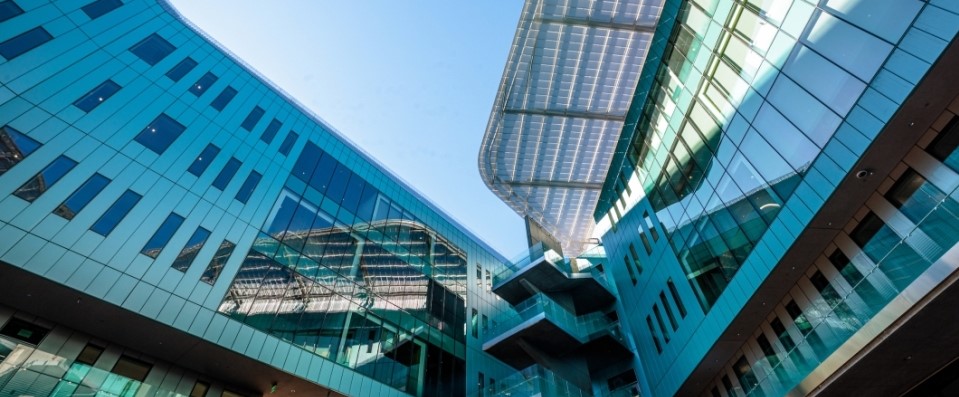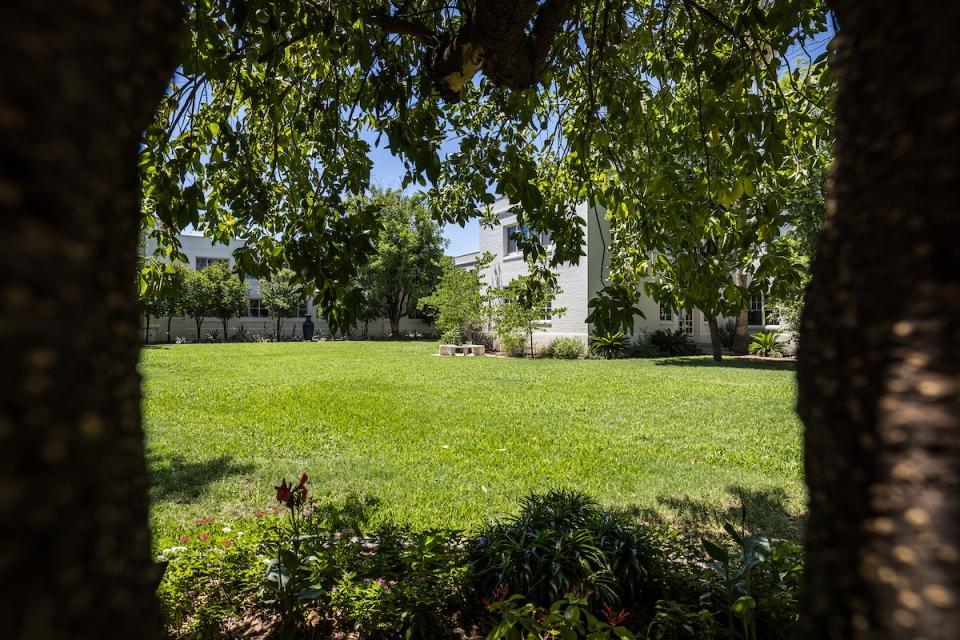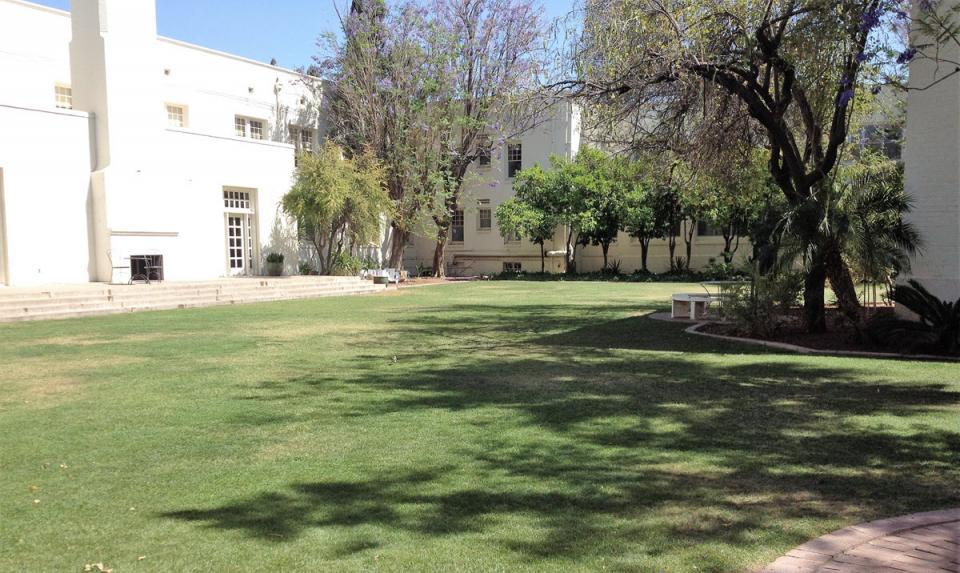The Secret Garden
A clandestine perspective
Several years prior to the COVID shutdown, a series of curious graffiti appeared on the sidewalks of ASU Tempe. Stenciled in black chalk, they proffered directions to the legendary Secret Garden, a place of respite and refuge imbedded deep in a complex of buildings from another age. Arguably the work of a Good Samaritan seeking to enlighten new arrivals on our lesser known offerings, these helpful signposts nevertheless violated the very spirit of the graffito, which ever strives to subvert, offend, and challenge the social order. Clearly, a correction was needed, and was provided by a resourceful trickster who erased the existing arrows and re-stenciled them to point in the wrong direction.
Perhaps the lesson here is that our hidden places should on some level remain inviolate—lost worlds akin to those of H. Rider Haggard and Talbot Mundy that call out to the imagination and the impulse to discover and explore. Now, most of you know that the location of the Secret Garden isn’t much of a secret; ask any three people on campus and you will get at least one set of directions. However, you won’t get them from me, for in the words of Number Two in the great British spy drama "The Prisoner," “That would be telling.”
But I will take you on a brief tour. There are several ways in. On the north end of the complex of buildings that surround our destination, a ramp breaks from the sidewalk and descends for several yards before taking a sharp left into a gloomy tunnel edged by a wrought iron gate that appears never to have been closed. On your right, you will pass several ornate incinerator doors painted shut with the same rust-caked white that covers the gate. Hardly the welcome you would expect from a destination of the Secret Garden’s gentle repute, but all is not lost. What appears to be the first branch of a Stygian labyrinth ascends, giving way to the sublime as the tunnel opens onto a place of wonder.
Not as lush as the verdant greenspace cherished by Colin, Mary, and Dickon in the Frances Hodgson Burnett novel, the Secret Garden is nevertheless splendid in its simplicity. The lawn at its center is surrounded by whitewashed buildings that were once women’s dormitories; between them, a profusion of plant life that reflects the botanical diversity of the ASU Arboretum. Look to your left as you enter and you will see Jacaranda trees, flowering in intense purple if you’re lucky enough to be here in late spring. Making the rounds of the garden you will run into sour orange and Hindu laurel, plumeria, guava, and blue butterfly bush as well as an array of cacti and ferns, all sparsely placed and intermingled with commemorative spaces and benches. On the south wing, a large vase glazed in deep indigo marks a plaque dedicated to a professor of years past. Several yards to its right, a small bench of stone and wood, surrounded by cactus, is connected to the lawn by a walkway of brick steps.
Where the north and east wings join, a barely noticeable statuette of two figures embracing appears to emerge from the earth. At its base lies another plaque, all but covered in dirt and leaves. A ways to the right, a stone bench leans against the wall of the east wing. Across the lawn stands another, constructed of three arcs forming a circle, each supported by crouching lions. Not especially comfortable by the look of it, but nowhere near as daunting as the spine-wrenching Philomathian seat that graces Old Main Lawn.
If there is a focal point to the Garden it is the outdoor fireplace that extends from the east wing of the complex. Flanked by art deco glass doors, it opens onto a narrow stage and several feet of steps that descend into the lawn. Shortly before the onset of the Second Iraq War, ASU students and faculty congregated around the stage to hear and read poetry that explored the experience of war and its effects on its participants and victims. Bert Bender, an army veteran and professor of American literature who arranged the gathering with then-English department chair Elizabeth Horan, read Stephen Crane’s “War is Kind.” Its biting, poignant ironies were sadly prophetic of the storm to come.
Today, the Garden occasionally hosts group events, but you are more likely to run into solitary visitors reading, napping, perhaps even doing homework. Stainless steel chairs offer an alternative to the charming yet intimidating stone benches, and there is always the comfort of the grass.
My mother studied classical piano at ASU in the late 1940s. She would have known this place and may have even lived in one of the dorms. The galleries on the north wing look like they could have served as the sleeping porches she described, screened and perhaps hung with wet sheets to cool the air. The Garden must have been a lively place then, as anyone who has lived in a dormitory opening into a courtyard could attest.
The folklorist in me is tempted to concoct and spread a legend comparable to that in Brigadoon, in which the Secret Garden appears only once every twenty years and can be seen only by true lovers and people of good heart. It is populated by hepsters from the 1930s wearing zoot suits, lettermen’s sweaters, and cheerleading jerseys. Cab Calloway and his band play on the stage, the crowd jumps to the Lindy Hop, and everything is copacetic.
Well, that wouldn’t be ethical, and you can make up your own stories given the proper inspiration. But first, you must claim a spot on the lawn of the Secret Garden and lay out a serviceable blanket and a comfy pillow to support your elbow.
Then, you open a book.
Image 1: A clandestine view from inside the Secret Garden. Photo by Charlie Leight/ASU.
Image 2: Blossoms on a jacaranda tree, ASU Tempe campus. Photo by Charlie Leight/ASU.
Image 3: A whitewashed building and the chimney, stage and stairs viewable from inside the Secret Garden. Photo by Marilyn Arevalo/ASU.
Image 4: An ASU student spends quiet time in the Secret Garden. Photo by Charlie Leight/ASU.




